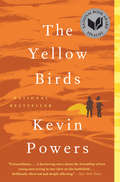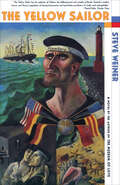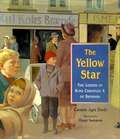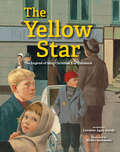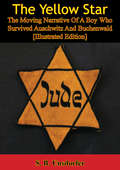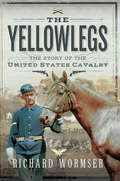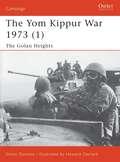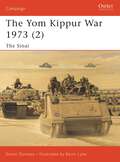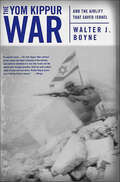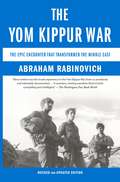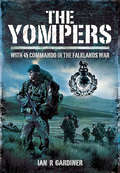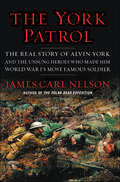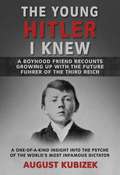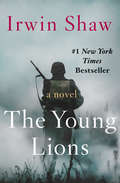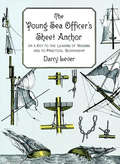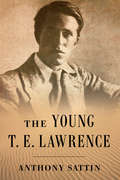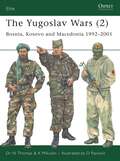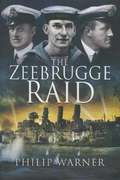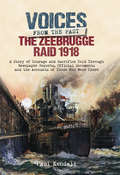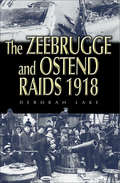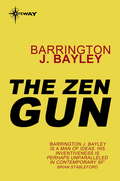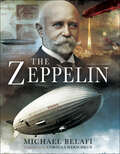- Table View
- List View
The Yellow Birds: A Novel (Litterature & Documents Ser.)
by Kevin Powers<P>A novel written by a veteran of the war in Iraq, The Yellow Birds is the harrowing story of two young soldiers trying to stay alive. <P>"The war tried to kill us in the spring." <P> So begins this powerful account of friendship and loss. In Al Tafar, Iraq, twenty-one-year old Private Bartle and eighteen-year-old Private Murphy cling to life as their platoon launches a bloody battle for the city. Bound together since basic training when Bartle makes a promise to bring Murphy safely home, the two have been dropped into a war neither is prepared for. <P>In the endless days that follow, the two young soldiers do everything to protect each other from the forces that press in on every side: the insurgents, physical fatigue, and the mental stress that comes from constant danger. <P> As reality begins to blur into a hazy nightmare, Murphy becomes increasingly unmoored from the world around him and Bartle takes actions he could never have imagined. <P>With profound emotional insight, especially into the effects of a hidden war on mothers and families at home, The Yellow Birds is a groundbreaking novel that is destined to become a classic.
The Yellow Sailor: A Novel
by Steve WeinerIn this surreal & dramatic novel set at the dawn of World War I, a German merchant ship wrecks, and its crew of five drift their separate ways. This extraordinary novel, moodily operatic in tone and by turns hallucinatory and brilliantly detailed, follows the trajectories of four sailors and the owner of a German merchant ship, Yellow Sailor, which sets sail from Bremen in 1914. After the ship wrecks in shallow water, the men drift their separate ways, with each man&’s journey across a desolate wartime European landscape becoming an exploration of the failure of love, sex, religion, and friendship . . . Julius Bernai, owner of the ship and frankly homosexual, checks into an institute for nervous disorders and falls in love with the doctor&’s fiancée. Nicholas Bremml drifts: from the beds of numerous prostitutes to an oil tanker called Erwartung— Expectation—to Prague&’s Jewish market, where he sells magic spells. Brothers Karl and Alois are equally rudderless, and Jacek, the electrician, goes to work in the mines, where his love advice to a fourteen-year-old Polish boy precipitates a macabre murder . . .Praise for The Yellow Sailor &“The Yellow Sailor has the calamity of Voltaire, the disillusionment and venality of Brecht, Kasinski&’s random horror, and Grosz&’s population of leering businessmen and hard-bitten prostitutes. . . . It&’s bold and unforgettable.&” —David Finkle, Trenton Times
The Yellow Star: The Legend of King Christian X of Denmark
by Carmen Agra Deedy Henri SorensenWithout the yellow star to point them out, the Jews looked like any other Danes. For centuries, the Star of David was a symbol of Jewish pride. But during World War II, Nazis used the star to segregate and terrorize the Jewish people. Except in Denmark. When Nazi soldiers occupied his country, King Christian X of Denmark committed himself to keeping all Danes safe from harm. The bravery of the Danes and their king during that dangerous time has inspired many legends. The most enduring is the legend of the yellow star, which symbolizes the loyalty and fearless spirit of the king and his people. Award-winning author and storyteller Carmen Deedy has poignantly recreated this legend, which is accompanied by Danish illustrator Henri Sørensen's arresting full-color portraits. The result is a powerful and dignified story of heroic justice, a story for all people and all times.
The Yellow Star: The Legend of King Christian X of Denmark
by Carmen Agra DeedyWithout the yellow star to point them out, the Jews looked like any other Danes. In 1940, Nazis occupied Denmark and King Christian X, beloved amongst his people, had to find some way to resist their overwhelming power. When the order went out that all Jews must wear a yellow star on their clothes, the king had an idea that might just work. But it would take the faith and commitment of all Danes.In this retelling of a World War II legend, New York Times best-selling author Carmen Agra Deedy poignantly remind us of the power of a good, wise leader. Paired with Henri Sørensen's arresting full-color portraits, this is a powerful and dignified story of heroic justice.
The Yellow Star: The Moving Narrative Of A Boy Who Survived Auschwitz And Buchenwald [Illustrated Edition]
by S. B. UnsdorferIncludes 204 photos, plans and maps illustrating The Holocaust"Simcha Bunem Unsdorfer was the son of a well-known rabbi in Bratislava, the mother community for the Jewish population of Czechoslovakia. Because of the importance of his father's position, the family was permitted to remain in the city after the German occupation during World War II. Eventually, however, the family was deported to the infamous camps of Auschwitz where the Unsdorfers were separated and the parents killed. Their nineteen-year-old son Simcha was transferred from Auschwitz to work in an airplane factory in the Buchenwald camp. Throughout his long and terrible ordeal, he and his fellow prisoners were mercilessly molested by the S.S. men, but they held on to life tenaciously, their faith in God and His Torah never wavering. When the war finally ended, workers and prisoners were freed and permitted to go home. Home! Home! cried the Czechs, dancing and kissing in mad jubilation. We, the Jews, sank down on the floor again...Home Home What a travesty. Home a place that no longer was, and never would be again. Free...What were we freed for? Only to mourn and lament for the rest of our days over the greatest tragedy that had ever befallen our people in our long and trying history. Simcha Bunem Unsdorfer has written a deeply moving account of his experiences as a devout Jew in the concentration camps and factories of the Nazi Reich. The Yellow Star is a painful story, but a heroic one, a book which cogently describes the Divine strength inherent in the Jewish soul."-Print ed.
The Yellowlegs: The Story of the United States Cavalry
by Richard WormserThe colorful, action-packed early history of the horse-riding branch of the U.S. Army. In this comprehensive and lively account, Richard Wormser—who was himself an enthusiastic horseman—narrates the major events and characters of the U.S. Cavalry&’s formative, and, some might say fruitful, years. From the American Revolution and the exploits of men such as Henry &“Light-Horse Harry&” Lee III and Francis Marion, the first of the guerrillas, the author follows on with Stephen Kearny, the &“Father of the Cavalry&” whose dragoons went west to California on mules, and his nephew Philip, who organized the famed Gray Horse Troop of the Mexican War. Other famous names featured include Jonathan &“Stonewall&” Jackson; George Crook, who admired the Indians it was his duty to hunt down; and George Armstrong Custer. A U.S. Army officer and cavalry commander who served with distinction in the American Civil War, Custer is most remembered for leading more than 200 of his men to their deaths in the Battle of the Little Bighorn in June 1876. Also known as &“Custer&’s Last Stand&’, Bighorn was part of the Black Hills War against a confederation of Plains Indians, including the Cheyenne and Dakota Sioux. It remains one of the most controversial battles in American history. Roosevelt&’s Roughriders and Black Jack Pershing, who led his troops in an automobile, complete the narrative—one which is undoubtedly a saga of daring raids, of epic marches, and of grueling battles. As the author reveals, the story of the U.S. Cavalry is also the story of the birth and growth of America itself.
The Yom Kippur War 1973
by Howard Gerrard Simon DunstanOsprey's first title in the study of the Yom Kippur War (1973). At 1345hrs on 6 October 1973, Israeli spotters in the observation post atop Mount Hermon saw Syrian gunners below them removing the camouflage nets from their guns. Ten minutes later shells began to rain down on Israeli positions all along the Golan Heights - The Yom Kippur War had begun. The shock Syrian attack caught the Israelis by surprise and by the afternoon of 7 October a Syrian brigade was less than 10km from the Sea of Galilee. Simon Dunstan describes in detail how amid desperate and bitter fighting the Israeli forces managed to turn the tide on the Golan Heights.
The Yom Kippur War 1973
by Kevin Lyles Simon DunstanOsprey's second title in the study of the Yom Kippur War (1973). Israel's victory in the 1967 'Six Day War' sowed the seeds of the 1973 Yom Kippur War. At 1400hrs on 6 October 1973 the Egyptian army launched an assault crossing of the Suez Canal. The carefully co-ordinated attack achieved complete tactical surprise. The sand embankments of the Israeli Bar-Lev Line were breached and an Israeli counterattack thrown back with heavy losses. In the second of his two-volume analysis of the Yom Kippur War, Simon Dunstan details the fighting in the Sinai, culminating in Operation Gazelle, the Israeli counterattack across the Suez Canal. Although defeated militarily Egypt did ultimately succeed in forcing the Israelis back to the negotiating table.
The Yom Kippur War: And the Airlift Strike That Saved Israel
by Walter J. BoyneWalter J. Boyne's The Yom Kippur War is a spellbinding chronicle of the international chess game that was played out in October 1973. It is a story of diplomacy and military might that accounts for many of the dilemmas faced in the present-day Middle East. It's usually called the Yom Kippur War. Or sometimes the October War. The players that surround it are familiar: Sadat and Mubarak, Meir and Sharon, Nixon and Kissinger, Brezhnev and Dobyrnin. It was a war that brought Arab and Jew into vicious conflict. A war in which Israel almost unleashed her nuclear arsenal and set two superpowers on a treacherous course of nuclear escalation. And a war that eventually brought peace. But a peace fraught with delicate tensions, disputed borders, and a legacy of further bloodshed. This is a war that Israel never thought was possible. Surprised by the fury and excellent execution of the Arab onslaught, and perhaps more than a little complacent, Israel suddenly found itself on the point of losing a war because of a lack of ammunition, planes and tanks. The United States, after much vacillation, finally elected to help Israel, beginning a tremendous airlift (code name: Operation Nickel Grass) which incurred the wrath of the Arab states, and their sponsor, the Soviet Union. Fortunately, the airlift came just in time for Israeli ground forces to stabilize their positions and eventually turn the tide in the Sinai and Golan Heights. And it was all made possible by an operation that dwarfed the Berlin Airlift and the Soviets' simultaneous efforts in Egypt and Syria.The Yom Kippur War is bound to become the definitive history of a war that quite literally approached Armageddon.
The Yom Kippur War: The Epic Encounter That Transformed the Middle East
by Abraham RabinovichA US journalist now living in Jerusalem who has written several books on Israel chronicles the 1973 war that dramatically altered the regional map and politics. Based on interviews with Israeli Army commanders and other sources, this account also discusses Arab perspectives and the war's legacy, and includes photos and maps. Annotation ©2004 Book News, Inc. , Portland, OR (booknews. com)
The Yompers: With 45 Commando in the Falklands War
by Ian GardinerCalled to action on 2 April 1982, the men of 45 Commando Royal Marines assembled from around the world to sail 8,000 miles to recover the Falkland Islands from Argentine invasion. Lacking helicopters and short of food, they yomped in appalling weather carrying overloaded rucksacks, across the roughest terrain. Yet for a month in mid-winter, they remained a cohesive fighting-fit body of men. They then fought and won the highly successful and fierce night battle for Two Sisters, a 1,000 foot high mountain which was the key to the defensive positions around Stanley.This is a first hand story of that epic feat, but it is much more than that. The first to be written by a company commander in the Falklands War, the book gives a compelling, vivid description of the yomp and infantry fighting, and it also offers penetrating insights into the realities of war at higher levels. It is a unique combination of descriptive writing about front-line fighting and wider reflections on the Falklands War, and conflict in general.Gritty and moving; sophisticated, reflective and funny, this book offers an abundance of timeless truths about war.Postscript: Yomping was the word used by the Commandos for carrying heavy loads on long marches. It caught the publics imagination during this short but bitter campaign and epitomized the grim determination and professionalism of our troops.
The York Patrol: The Real Story of Alvin York and the Unsung Heroes Who Made Him World War I's Most Famous Soldier
by James Carl Nelson"Exceptional military history worthy of its heroic subject." —Matthew J. DavenportIn the vein of Band of Brothers and American Sniper, a riveting history of Alvin York, the World War I legend who killed two dozen Germans and captured more than 100, detailing York's heroics yet also restoring the unsung heroes of his patrol to their rightful place in history—from renowned World War I historian James Carl Nelson.October 8, 1918 was a banner day for heroes of the American Expeditionary Force. Thirteen men performed heroic deeds that would earn them Medals of Honor. Of this group, one man emerged as the single greatest American hero of the Great War: Alvin Cullum York. A poor young farmer from Tennessee, Sergeant York was said to have single-handedly killed two dozen Germans and captured another 132 of the enemy plus thirty-five machine guns before noon on that fateful Day of Valor. York would become an American legend, celebrated in magazines, books, and a blockbuster biopic starring Gary Cooper. The film, Sergeant York, told of a hell-raiser from backwoods Tennessee who had a come-to-Jesus moment, then wrestled with his newfound Christian convictions to become one of the greatest heroes the U.S. Army had ever known. It was a great story—but not the whole story.In this absorbing history, James Carl Nelson unspools, for the first time, the complete story of Alvin York and the events that occurred in the Argonne Forest on that day. Nelson gives voice, in particular, to the sixteen “others” who fought beside York. Hailing from big cities and small towns across the U.S. as well as several foreign countries, these soldiers included a patrician Connecticut farmer whose lineage could be traced back to the American Revolution, a poor runaway from Massachusetts who joined the Army under a false name, and a Polish immigrant who enlisted in hopes of expediting his citizenship. The York Patrol shines a long overdue spotlight on these men and York, and pays homage to their bravery and sacrifice. Illustrated with 25 black-and-white images, The York Patrol is a rousing tale of courage, tragedy, and heroism.
The Young Hitler I Knew: A Boyhood Friend Recounts Growing Up with the Future Fuhrer of the Third Reich
by Mr. August KubizekAugust Kubizek met Adolf Hitler in 1904 while they competed for standing room at the opera. Kubizek describes a reticent young man, painfully shy, yet capable of bursting into hysterical fits of anger if anyone disagreed with him. But they grew close, often talking for hours on end. In 1908, they began sharing an apartment in Vienna. After being rejected twice from art school, Hitler found himself sinking into an unkind world of &“constant unappeasable hunger.&” Kubizek did not meet his friend again until he congratulated him on becoming Chancellor of Germany. The Young Hitler I Knew tells the story of an extraordinary friendship, and gives fascinating insight into Hitler&’s character during these formative years.
The Young Lions
by Irwin ShawStanding alongside Norman Mailer's The Naked and the Dead and James Jones's From Here to Eternity, The Young Lions is one of the most powerful American novels to tackle the Second World War. Ambitious in its scope and robust in its prose, Irwin Shaw's work is also deeply humanistic, presenting the reality of war as seen through the eyes of ordinary soldiers on both sides. The story follows the individual dramas — and ultimately intertwined destinies — of Christian Diestl, a Nazi sergeant; Noah Ackerman, a Jewish American infantryman; and Michael Whitacre, an idealistic urbanite from the New York theatrical world. Diestl first appears as a dashing ski instructor in Austria, mouthing his loyalty to Nazi ideals. As the war progresses, Diestl's character continues to erode as he descends into savagery. Ackerman must endure domestic anti-Semitism and beatings in boot camp before proving himself in the European theater. Eventually, as part of the liberating army, he comes face-to-face with the unimaginable horrors of the death camps. Whitacre, trading cocktail parties for Molotov cocktails, confronts the barbarism of war, and in fighting simply to survive, finds his own capacity for heroism. Shaw's sweeping narrative is at once vivid, exciting, and brutally realistic as well as poignant in its portrayal of the moral devastation and institutional insanity of war. Penned by a master storyteller at the height of his craft, The Young Lions stands the test of time as a classic novel of war and the human experience.
The Young Lions: A Novel
by Irwin ShawOne of the great World War II novels, this New York Times–bestselling &“masterpiece&” captures the experiences of three very different soldiers (The Boston Globe). Standing alongside Norman Mailer&’s The Naked and the Dead and James Jones&’s From Here to Eternity, The Young Lions is one of the most powerful American novels to tackle the Second World War. Ambitious in its scope and robust in its prose, Irwin Shaw&’s work is also deeply humanistic, presenting the reality of war as seen through the eyes of ordinary soldiers on both sides. The story follows the individual dramas—and ultimately intertwined destinies—of Christian Diestl, a Nazi sergeant; Noah Ackerman, a Jewish American infantryman; and Michael Whitacre, an idealistic urbanite from the New York theatrical world. Diestl first appears as a dashing ski instructor in Austria, mouthing his loyalty to Nazi ideals. As the war progresses, Diestl&’s character continues to erode as he descends into savagery. Ackerman must endure domestic anti-Semitism and beatings in boot camp before proving himself in the European theater. Eventually, as part of the liberating army, he comes face-to-face with the unimaginable horrors of the death camps. Whitacre, trading cocktail parties for Molotov cocktails, confronts the barbarism of war, and in fighting simply to survive, finds his own capacity for heroism. Shaw&’s sweeping narrative is at once vivid, exciting, and brutally realistic as well as poignant in its portrayal of the moral devastation and institutional insanity of war. Penned by a master storyteller at the height of his craft, The Young Lions stands the test of time as a classic novel of war and the human experience. This ebook features an illustrated biography of Irwin Shaw including rare images and never-before-seen documents from the author&’s estate.
The Young Lions: A Novel (Phoenix Fiction Ser.)
by Irwin ShawOne of the great World War II novels, this New York Times–bestselling &“masterpiece&” captures the experiences of three very different soldiers (The Boston Globe). Standing alongside Norman Mailer&’s The Naked and the Dead and James Jones&’s From Here to Eternity, The Young Lions is one of the most powerful American novels to tackle the Second World War. Ambitious in its scope and robust in its prose, Irwin Shaw&’s work is also deeply humanistic, presenting the reality of war as seen through the eyes of ordinary soldiers on both sides. The story follows the individual dramas—and ultimately intertwined destinies—of Christian Diestl, a Nazi sergeant; Noah Ackerman, a Jewish American infantryman; and Michael Whitacre, an idealistic urbanite from the New York theatrical world. Diestl first appears as a dashing ski instructor in Austria, mouthing his loyalty to Nazi ideals. As the war progresses, Diestl&’s character continues to erode as he descends into savagery. Ackerman must endure domestic anti-Semitism and beatings in boot camp before proving himself in the European theater. Eventually, as part of the liberating army, he comes face-to-face with the unimaginable horrors of the death camps. Whitacre, trading cocktail parties for Molotov cocktails, confronts the barbarism of war, and in fighting simply to survive, finds his own capacity for heroism. Shaw&’s sweeping narrative is at once vivid, exciting, and brutally realistic as well as poignant in its portrayal of the moral devastation and institutional insanity of war. Penned by a master storyteller at the height of his craft, The Young Lions stands the test of time as a classic novel of war and the human experience. This ebook features an illustrated biography of Irwin Shaw including rare images and never-before-seen documents from the author&’s estate.
The Young Sea Officer's Sheet Anchor: Or a Key to the Leading of Rigging and to Practical Seamanship
by Darcy LeverWidely used among young 19th-century officers in the Royal Navy and East India Company, this now-rare volume offers clear definitions and copious illustrations of the principles of rigging and other aspects of seamanship -- tacking, use of a compass, splicing ropes, making sails, and much more. A must for ship fanciers and naval historians.
The Young T. E. Lawrence
by Anthony SattinAn intimate biography of the years that turned T. E. Lawrence into Lawrence of Arabia. Lawrence of Arabia's heroism during the Arab revolt and his disgust at the subsequent betrayal of the Arabs in the postwar negotiations have become the stuff of legend. But T. E. Lawrence's adventures in the Levant began long before the outbreak of war. This intimate biography is the first to focus on Lawrence in his twenties, the untold story of the awkward archaeologist from Oxford who, on first visiting "The East," fell in love with Arab culture and found his life's mission. Few people realize that Lawrence's classic autobiography, Seven Pillars of Wisdom, was not the first book to carry that iconic title. Lawrence himself burned his original draft. Anthony Sattin here uncovers the story Lawrence wanted to conceal: the truth of his birth, his tortuous relationship with a dominant mother, his deep affection for an Arab boy, and the personal reasons that drove him from student to spy. Drawing on surviving letters, diaries, and accounts from close confidantes, Sattin brings a biographer's eye for detail and a travel writer's verve to Lawrence's extraordinary journeys through the region with which his name is forever connected. In a masterful parallel narrative, The Young T. E. Lawrence charts the maturation of the man and the incipient countries he treasured, both coming of age at a time when the world's foundations were coming undone.
The Yugoslav Wars
by Nigel Thomas Darko Pavlovic K. MikulanOsprey's examination of Bosnia, Kosovo and Macedonia's involvement in the Yugoslav Wars (1991-1995), as well as their involvement in the conflicts of the years that followed. Following the death of the Yugoslavian strongman President Tito in 1980, the several semi-autonomous republics and provinces that he had welded into a nation in 1945 moved inexorably towards separation. As the world watched a series of wars ripped through this modern European state. In this second of two volumes, experts on the Balkan region give an unprecedented, clear and concise explanation of the armies of the the Bosnian Civil War 1992-5 as well as the conflicts in Kosovo and Macedonia. This includes the regular and militia forces which fought in these campaigns and which ultimately resulted in the UN/NATO policing of the region that continues to this day. The book is illustrated with rare photos and an extraordinary range of colour uniform plates.
The Zealot: A Roman Legion Novel
by Simon ScarrowThe thrilling adventures of two Roman centurions continue as they’re called to stop a threat rising in the Empire’s eastern provinces.Trouble is brewing on the eastern frontier of the Roman Empire. The troops are in a deplorable state, while the corrupt behavior of their senior officers threatens to undermine the army’s control of the region. To restore competence of the men defending a vital fort, two experienced centurions are dispatched to Judea. On their arrival Cato and Macro discover that Bannus, a local tribesman, is fomenting rebellion among the followers of Jehoshua, who was crucified in Jerusalem some seventeen years earlier. As the local revolt grows, Rome’s longstanding enemy Parthia is poised to invade, Cato and Macro must stamp out corruption in the cohort before the Eastern provinces are lost forever . . . Simon Scarrow’s Roman Legion series chronicling the adventures of centurions Cato and Macro has been met with near universal acclaim, drawing comparisons to the best of his contemporaries including Bernard Cornwell, Conn Iggulden, and Harry Sidebottom. A master of his craft, Simon Scarrow combines stunning historical detail with riveting battles and rich characters to bring the Roman Empire to life as never before.Originally published in the UK as The Eagle in the SandPraise for Simon Scarrow’s Roman Legion series“I really don’t need this kind of competition.” —Bernard Cornwell“Scarrow manages to summon up all the glory and the gore that characterized life in the Roman legions. Outstanding . . . a new master of the genre.” —Booklist“A combustible concoction of intrigue, treachery, and violence. . . . Scarrow’s combat is brutal and sanguinary; his imperial politics are almost as sharp.” —Publishers Weekly“Scarrow again provides a vivid sense of history and believable scenes of maritime action. His righteous but flawed protagonists are winning heroes.” —Kirkus Reviews“All the hallmarks of Bernard Cornwell at his best.” —Oxford Times
The Zeebrugge Raid
by Philip WarnerOn 23 April 1918 a force drawn from the Royal Navy and Royal Marines launched one of the most daring raids in history. The aim was to block the Zeebrugge Canal, thereby denying U-boat access, although this meant assaulting a powerfully fortified German naval base. The raid has long been recognised for its audacity and ingenuity but, owing to the fact that the official history took overmuch notice of the German version of events, has been considered only a partial success. The error of that view is now exposed, for in this stirring account there is evidence from many sources that the raid achieved much more than is usually credited to it. The raid is presented from a variety of viewpoints, from the airmen who took part in the preliminary bombing to the motor launches which picked up survivors. The crews of the launches and coastal motor boats were frequently 'amateur' sailors but their courage and skill were second to none. Philip Warner has talked with many of the survivors and corresponded with others, some of whom now live in distant parts of the world.
The Zeebrugge Raid 1918: A Story of Courage and Sacrifice Told Through Newspaper Reports, Official Documents and the Accounts of Those Who Were There (Voices from the Past)
by Paul KendallApproximately a third of all Allied merchant vessels sunk during the First World War were by German boats and submarines based at Bruge-Zeebrugge on the coast of Belgium. By 1918 it was feared that Britain would be starved into surrender unless the enemy raiders could be stopped. A daring plan was therefore devised to sail directly into the heavily defended port of Zeebrugge and then to sink three obsolete cruisers in the harbour in the hope they would block German vessels from reaching the English Channel. The cruisers were also to be accompanied by two old submarines, which were filled with explosives to blow up the viaduct connecting the mole to the shore, whilst 200 Marines were to be landed to destroy German gun positions at the entrance to the Bruges Canal.On 23 April the most ambitious amphibious raid of the First World War was carried out, told here through a huge collection of personal accounts and official reports on the bitter fighting which saw more than 500 British casualties from the 1,700 men who took part, and saw the awarding of eight Victoria Crosses.
The Zeebrugge and Ostend Raids 1918 (Battleground Channel Ports Ww1 Ser.)
by Deborah LakeThe unrestricted U-Boat war threatened the very survival of Britain, whose reliance on imported food and war materials was her Achilles Heel. A significant element of the German submarine fleet operated from the occupied Belgian ports of Zeebrugge and Ostend. After careful planning the Royal Navy launched audacious attacks on these two ports on St Georges Day 1918. Five obsolete cruisers and two Mersey ferries supported by a flotilla of smaller vessels penetrated the near impregnable defenses, while Royal Marines and naval storming parties battle ashore in a diversionary attack. At the time of the action the concrete filled block ships were scuttled in the ports approaches.Despite being a costly and bloody affair for the participants, the survivors returned to acclaim. The raids gave a fillip to the national morale, at a time of depressing news from the Front. To underline the success of the affair no less than 11 Victoria Crosses were awarded.
The Zen Gun
by Barrington J. BayleyPout, the chimera, half-man, half-ape, was incorporated into one of the plants or vice versa. He was jammed into a squatting position, while the stems, entering at his buttocks, merged with his legs, his arms and his torso, emerging at knees, elbows, and through his abdomen and thorax. A large, yellow-petalled flower seemed to frame his face.It was his face that rivetted Ikematsu's attention, while the chimera squirmed in dumb distress, glaring with huge piteous eyes. For in that face, set into it as if set in pudding, was the zen gun. The gun was his face, or a part of it. The barrel pointed straight out in place of a nose... the stock merged with and disappeared into Pout's pendulous mouth. Ikematsu leaned toward the chimera. "How you loved your toy! Now it is truly yours!"
The Zeppelin
by Michael BelafiThis new publication from Michael Belafi offers some truly intriguing content. Photographs of the mighty Zeppelin at all stages of development feature in a publication that aims to chart the entire course of the airship's history. Named after the German Count Ferdinand Von Zeppelin, an early pioneer of rigid airship development, the Zeppelin was first flown commercially by Deutsch Luftschiffahrts (DELAG), the world's first airline in revenue service. By mid–1914, DELAG had carried over 10,000 fare-paying passengers on over 1500 flights. When war hit, it was employed to military advantage, wreaking carnage upon Britain's towns and cities. German defeat in 1918 temporarily halted the airship business (many had to be surrendered under the terms of the Treaty of Versailles), although it did bounce back with the construction of the Graf Zeppelin in the 30s. A series of terrible accidents was soon to signal the demise of the Zeppelin however; following the Hindenburg disaster of 1937, and in the midst of a host of political and economic issues, the Zeppelin was soon to be consigned to the history books as one of the great aviation relics of the 20th Century. This new publication explores each facet of its history, and concludes by assessing the legacy of rigid airship development, still felt to this day.
